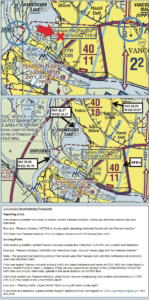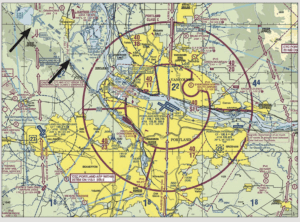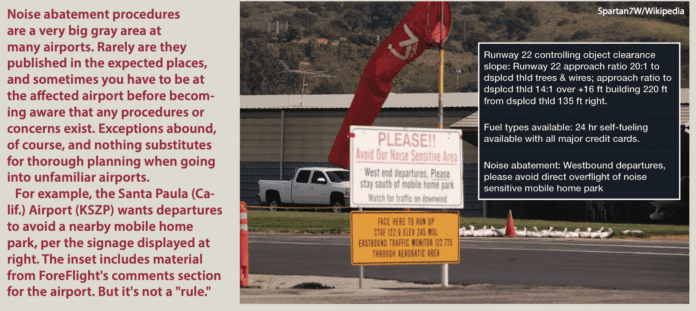I have always considered myself a pilot who plays by the rules. Dare I say I may be a “goody two-shoes” to some? But I’m always trying my best to be someone quite familiar with the wide range of regulations and procedures expected of me both as a general aviation and an airline flyer has served me well. Knock on wood—I have not been involved in any accidents, nor have I been the subject of FAA enforcement actions.
However, as I learned on a recent flight, there are some “rules” that I am expected to know and follow that cannot be found anywhere in the FARs or any other official aviation resource. I place the word “rules” in quotes because I view them as just that—subjective things to perhaps consider, maybe even refer to as “best practices,” but which do not fit the textbook rules we in aviation know all too well. Perhaps they’re best identified as one person’s or a group’s preferences. But I digress.
IT WAS A BEAUTIFUL DAY…
There I was, flying along one chilly but clear fall day. I was relatively cozy, with a quarter-tug on the heat knob, in an underpowered though agreeable (that day) Cessna 150, up at 7500 feet, trucking along at 105 knots. I was lucky to be taking advantage of one of the few days conducive to VFR cross-country flying in the Pacific Northwest at that time of year. I was on a flight from the Portland, Oregon, area to the Pacific Coast and back. It was a lovely day on the coast, providing smooth landings at Pacific City State and Nehalem Bay State airports. I was even surprised by a much-improved-looking airstrip at Pacific City—the last time I had seen it from the ground, it was decrepit and unwelcoming—but today, it had a fresh coat of paint and seemed to be in much better condition than I remembered.
There were hardly any souls on any of the beaches. Not even many cars in the parking lot at the beachfront Pelican Brewery. I did not see another aircraft the whole time I cruised along the coast. This part of the flight went off without a hitch.
Upon heading back toward Portland, it became apparent that a weather system was thinking about heading into town to spoil the nice run of weather. Thankfully, it was still a ways off but close enough to bring some clouds into the area. Thus the aforementioned higher cruise arrangement, some scattered clouds, prompting me to go up to 7500 feet.
This also provided the advantage of staying out of the way of all the flight training aircraft also taking advantage of the excellent weather. They were all well below me while doing their maneuvers southwest and south of Hillsboro Airport (KHIO) (just west of Portland International [KPDX]). Another plus, or so I thought, was that I would be out of the hair of KPDX and KHIO traffic by being well above their Class C and D airspaces, respectively.

One source of continuing frustration for many pilots are the unpublished agreements between ATC facilities on how they will coordinate aircraft in each other’s airspace. The problem has little to do with how or what these agreements specify, although that can be an issue, too. Instead, it involves keeping this information out of the public eye, preventing pilots from being able to plan for and anticipate what they may be asked to do, and when.
A couple of years ago, I related the tale of a friend and I returning to Sarasota from Key West. We were IFR, and had filed via the Carnu intersection. From experience, I know that routing over Carnu allows a piston single to remain within gliding distance of land when at or above 8000 feet msl along that route. In the single we were flying that day, that’s a good thing.
But it was not to be. Miami Center rerouted us before we got to Carnu, placing us further out over the Gulf of Mexico and extending the time we would be out of gliding distance to land. When I got home, I initiated a Freedom of Information Act request of the FAA, looking for any documentation from Miami ARTCC, Ft. Myers TRACON and/or Tampa TRACON. A few weeks later, I received a bundle of paper purporting to be a collection of any and all letters of agreement (LOAs), memoranda, etc., between the facilities. None of the data I obtained said anything about Carnu or transitions along that route at that altitude.
None of this is the end of the world—unless the engine quits—but it should be a lot easier to plan for and fly that route than it used to be. — J.B.
SURE, I’LL USE ATC, BUT…
I am not one to have a problem talking to ATC, but I also like having the flexibility to do what I want by not talking to them. Usually, I steer clear of the KPDX Class C by going below it, but I have also gone overhead at times. While I may not call up ATC, I always listen to the applicable ATC frequencies near a busy airport such as KPDX, whether above or below or circumventing such an airport’s airspace. This day was no exception.
I had already listened to D-ATIS to plan for my arrival at a nearby airport without weather and noted that KPDX departures and arrivals were using runways facing west. As such, I nudged a little closer to KPDX to help ensure that departures would be well below me. Knowing that I was 3500 feet above the top of Class C airspace, I didn’t think much more of it. I could easily see the traffic launching out of KPDX and noticed them on my ADS-B traffic displays.
Once abeam the KPDX runways, I initiated a descent to 5500 feet in preparation for the final descent into my destination, Grove Field (1W1), once I cleared the shelf of Class C on the northeast side. The winds actually favored landing toward the east at Grove, so my plan worked out nicely to do a circling descent to under the Class C’s upper tier, positioning for a 45-degree entry for left downwind.
I touched down softly with a chirp of the tires and allowed the aircraft to roll to the end. I should have known something was off because I felt like I was an exhibit at the zoo—all eyes on the ramp were turned on me. Then the guy who staffs the FBO came out and helped me tie down the airplane, which was not the sort of service I was used to post-flight. Then he spilled the beans.

Years ago, sectional charts did not include visual checkpoints. You know, those magenta flags that mark prominent places to use when communicating your position to ATC or other pilots. There are two on the sectional chart excerpt at top right, circled in blue. They’re helpful because they take the guesswork many pilots still use to determine their distance from the airport (GPS has helped a lot, but speculation still happens). But there are endless numbers of “checkpoints” that pilots and even ATC use that are not marked on charts. A few examples that could potentially confuse a non-local pilot can be found in the KPDX area.
One involves the KHIO airport, which is home to the largest flight school in the Pacific Northwest. To keep their operation running safely and smoothly, the school has developed procedures to direct traffic to and from practice areas to minimize conflicts among aircraft. To an unfamiliar pilot, though, the announcements can be confusing. For example, aircraft proceed to the “turning tree,” which is, you guessed it, a tree at which aircraft turn (and apparently used to use for turns on a point). I couldn’t tell you which tree is the “turning” one, but students, instructors and controllers at KHIO know all about it.
Another example is the “procedure” for approaching Pearson Field (KVUO). Inbound aircraft typically funnel to Vancouver Lake, a checkpoint that actually is charted. This is usually when folks contact KPDX, required by the Special Flight Rules Area in FAR Part 93. From there, local pilots follow a rail line to the south which takes them over a few factories, one of which will fill the cockpit with the smell of Fritos chips—the Frito-Lay factory. Pilots will generally report passing “Frito-Lay” from which they will enter downwind for Runway 26 or continue along the railway until turning final for Runway 7.
While we’re talking about unwritten rules, some rules are written but hidden. One such is the Special Flight Rules Area at KVUO itself, which is the subject of a letter to airmen (LTA) from the KPDX air traffic control tower. To find it, you need to dive into the FAA’s Notam system, at notams.aim.faa.gov. An excerpt is reproduced at bottom right.
For the uninitiated, the information about being over Frito-Lay is useless. This is just a reminder that not every pilot on the frequency is privy to local jargon. Therefore, it’s best to stick with objective checkpoints like those that are charted or by using mileage along with whatever miscellaneous ground objects one wants to include.
TIME TO CALL THE TOWER
“So uh, Portland approach just called and said that you just flew through their departure corridor,” he then looked up from the ground. “You didn’t do anything wrong, the guy said, but he wants you to call this number.” No pilot likes to hear the old “call this number” routine, myself included. I ran through the scenario a few times in my brain and cycled between a calm, logical response to being a little hot under the collar. After all, why do I need to call over something ATC admitted was not “wrong”?
So with a deep sigh, I called the number and listened as the controller made his case as to why he believed I was misguided for flying so close to the departure end of KPDX’s runways at the altitude I did. He even went as far as saying that he had “held up departures” and that my flight could have caused severe issues if, for some reason, the aircraft couldn’t have gotten a word in with departure right away. He said, “You didn’t do anything illegal,” and added that I should call approach next time.
I listened patiently and then stated that I have long been a bit perplexed as to why Portland is not yet a Class B airport, as busy as it has become and that perhaps traffic should not be authorized high enough to potentially conflict with overflights in airspace that was not under their jurisdiction. He immediately denied the potential for such solutions because it’s so hard to deal with the Port of Portland and some other semi-irrelevant details. Lastly, the controller offered to show me around the tower and approach sometime, and I thanked him for the opportunity. The whole thing left a bad taste in my mouth, so I decided to dissect the situation further.
Arriving home, I loaded the archive radar data and ATC communications from online resources. It turns out that no KPDX departures were “held up” instead, they received amended altitudes at which to level off after departure. At no point did I enter Class C airspace, and there were no close calls between myself and departures. Long story short, the controller did not like what I had done or how I had done it even in spite of the fact that—even as ATC admitted—I did nothing wrong or illegal.

Rather than leave pilots to learn about “rules” such as those discussed here the hard way, a simple fix might be to tweak available charts. Especially since changing airspace can be a long-drawn-out process (not to mention one with potential contention), a few added graphics to the TAC could make a big difference. An example of a possible amendment can be found on the Tampa TAC. Commonly used tracks of airliners are marked with blue jets and dashed lines along with the usual altitudes at which the aircraft can be found. This simple addition could be a game changer for KPDX, thus putting something in writing, so to speak. I doctored the KPDX sectional to show how the information could be conveyed, reproduced at right and highlighted by the black arrows. Arming pilots with this simple imagery would greatly assist them in safely and efficiently transitioning the area.
FINDING CLOSURE
So I was left pondering, how are pilots supposed to follow the rules or procedures that are not written down, such as in this case at KPDX? How are pilots supposed to operate “as if” they are in Class C even though they are not? I also wondered why jets were being initially cleared so high that they may conflict with en route overhead traffic outside of Class C?
Turbojets leaving KPDX are given 6000 as an initial altitude, which takes them well above the roof of the Class C at a time when they are changing frequencies from tower to departure (who is best informed about other transitory traffic). However, I had to admit that I was not entirely without “guilt.” In fact, my final assessment—perhaps why both players in this instance were frustrated—is that neither one of us was “right” or “wrong.”
I was not right because I could have chosen the safer option of talking to KPDX approach regardless of the airspace dimensions. I also could have abandoned my desire for autonomy by using one of the VFR transition routes depicted on the KPDX TAC. The controller was not wrong because the better option for both of us would have been for me to give approach a call. I, too, was not wrong because I flew things by the book, legally. I was well above Class C and never violated regulations. And ATC was not right in making what I did sound like I did something wrong—they knew well and good what a phone call to the tower usually means.
In retrospect, both parties in this caper could have performed better. I know I will definitely stay out of the way of KPDX because it is the safer, more prudent thing to do. I can only hope that as the KPDX terminal area continues to get busier, ATC will have some more forethought as to how to convey desired procedures to pilots and perhaps amend initial clearances to avoid conflicts with legal, albeit inconvenient for ATC, flights. Perhaps some changes to charting could help (see the sidebar above).
Moreover, perhaps it’s time to pressure the FAA to provide the necessary protections of Class B to the area. This is a classic example that the legal way isn’t always right. Further, if ATC expects pilots to play by their desired rules, they must better convey those expectations rather than asking them to call the tower after landing.
Therefore, while we sometimes run into unwritten and unofficial rules and procedures, we can be proactive in choosing the most conservative and communicative option. When in and around busy airspace, it’s best to chat with ATC. Also, recommended routes and procedures outlined on maps or in chart supplements should be viewed more as “preferred” or “necessary.”
A proactive mindset has kept me out of trouble so far, and it’s vital that I spread this thought process across all aspects of my flying, including what may not technically be governed by formal regulations or other stipulations. Lastly, this escapade reinforces a simple fact about flying—when deciding what to do, one should always ask themselves, “What is the safest option?” and choose that one over the others.
David C. Ison, PhD, has over 6000 hours of flight time, holds ATP MEL, commercial SEL/SES certificates and is an instrument and multi-engine flight instructor.





VERY similar circumstance!
D if you do, D if you don’t.
There is an even worse version of “unwritten rules” I call “tribal drums.” This is when you land at some rural non-towered field and the local “pilot commander” saunters out and tells you “we always turn base over the water tower” (or some similar local custom – recorded *nowhere*). Suddenly you are a pariah on the field because you violated a sacred local procedure only known to a privileged few. Hopefully, they still sell you gas and you can escape quickly 😫
David: Your drama suggests you belong in a soap opera… maybe in the third cut of Maverick? Then again, maybe some small airport denizens have earned the description. Dunno your life experiences in the hinterlands of America.
FWIW, over 40+ years and lotsa small rural airports I can think of just two incidents as you’ve described ’em… widely separated by years and space. I can think of far more times a helpful hangar owner pulled my plane into welcome cover out of a coming T-storm, tossed me the keys to their pickup to grab lunch or even an overnight hotel stay, or proffered some other very appreciated kindness.